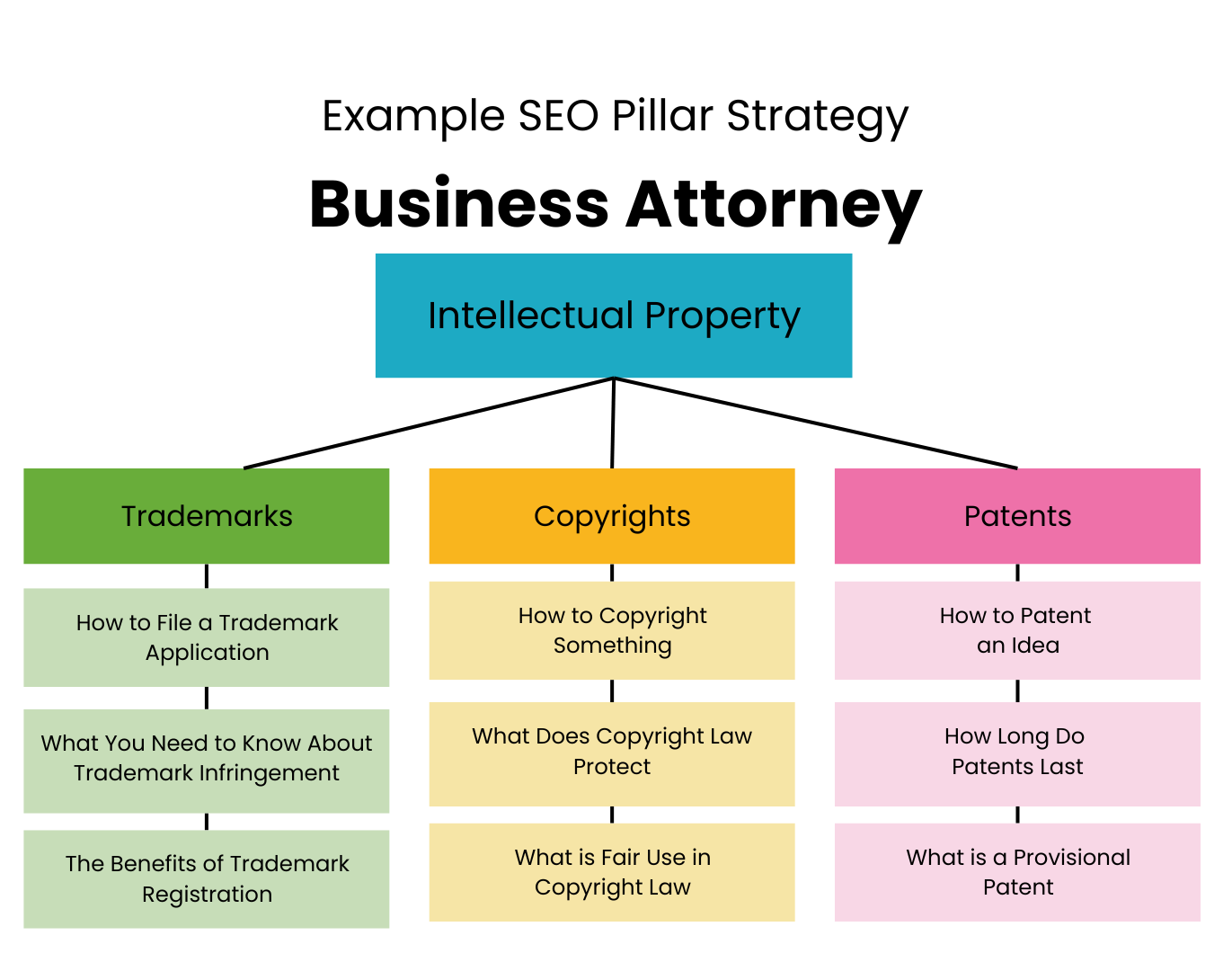You hear it everywhere, but what is pillar content, really? And is it still relevant to this new AI-driven age of search engine optimization? This in-depth article will explain everything you need to know about creating content pillars. You’ll learn how to establish your website as an authority and increase brand awareness in your niche.
Pillar content refers to comprehensive, informative content pieces that thoroughly cover a broad topic. They serve as cornerstones of your website, linking to related, shorter pieces known as cluster content. Think of it like building a house. The pillar content forms the strong foundation, while the cluster content acts like the supporting walls, adding further details and perspectives.
How Pillar Content Works for SEO
Pillar content helps search engines like Google understand the structure and hierarchy of information on your site. When you interlink pillar content and cluster content with a logical topic cluster strategy, you signal to search engines that your pillar page is the main authority on that subject.
A strong internal linking structure clarifies the organization of your content and enhances user experience. When readers can effortlessly navigate through interconnected content, they are more likely to engage and spend time on your site, which can ultimately lead to higher search rankings.
Besides attracting backlinks from other reputable sites, good pillar content acts like a vote of confidence. This vouching for your expertise boosts your website’s authority in the eyes of search engines.
Types of Pillar Pages You Can Create
Pillar content doesn’t come in a single flavor. Instead, you can structure this in-depth content into several formats that work best for your particular topic and goals:
-
-
Guide Pillars:
-
As the name suggests, these are complete, detailed guides about a topic, perfect for introducing a new concept or taking readers on a deep dive into a more complex subject. For example, you could write “SEO 101,” “How to Start an Online Store,” or “The Complete Guide to Time Tracking.”
-
-
What-is Pillars:
-
These pillar pages directly answer “What is [topic]?” searches and give a solid definition and overview of a particular subject. These are especially helpful for readers just beginning their exploration of a topic. They break down potentially unfamiliar concepts into clear explanations and address any questions someone may have when first learning about something new.
-
-
How-To Pillars:
-
These pillar pages focus on practical solutions and guide readers through a step-by-step process. Think “How to Paint a Room” or “How to Bake Sourdough Bread.” Each step is explained in detail within the pillar content, offering valuable and actionable information that helps readers achieve a particular outcome.

Five Steps for Creating Pillar Content That Attracts Backlinks
While creating pillar content demands effort, the long-term benefits make it a worthwhile investment. Here’s how you can craft impactful pillar pages:
1. Focus on Your Reader:
It’s about your reader. What do they need? What questions are they too embarrassed to ask? What problems can you help them solve?
Think like your ideal client and put yourself in their shoes. Remember those frustrations and challenges you faced when you were new to the game? Address those questions and provide insightful solutions, advice, or step-by-step guides. You might be surprised at how much overlap there is between your own journey and those of your audience.
Additionally, leverage valuable insights from social media platforms. Social media is an amazing opportunity to see what real people are saying, thinking, and doing. Professional platforms like LinkedIn or forums host more sophisticated business discussions. By observing these online dialogues, you’ll gain a treasure trove of topic ideas directly relevant to what your target audience cares about.
2. Choose Your Topic Clusters:
Let’s say you want to create a topic cluster on SEO. Your pillar page could be a complete article covering SEO basics. From your pillar page, you would add links to cluster pages.
3. Create and Optimize Your Content:
Start by thinking big picture and plan the content accordingly based on your target topics and their accompanying topic clusters (aka: cluster content). We know Google now factors search intent into their algorithm, so take your planning a step further. Go beyond just organizing the structure of the content – map out specific user journeys for each of your clusters.
Ask yourself what you want the person reading your content to learn. How do you want their journey with your company to go as they read through this specific pillar content and accompanying sub-topic clusters? Thinking through this ahead of time is a superpower. This level of deep strategy and understanding of how the user consumes your content will help ensure that you’re creating a website experience that not only caters to your audience’s needs but also caters to Google’s ever-evolving ranking factors. It’s a win, win.
4. Interlink It ALL.
The goal with all these internal links is a naturally-occurring ecosystem that both humans and robots will love. This linking process is how to best demonstrate E-E-A-T to Google. By consistently interlinking related pieces of content throughout your site you demonstrate that you are knowledgeable and have the experience to explain complex things simply. You also demonstrate that you understand all the details and are an expert on the subject matter, which makes you appear more authoritative.
5. Monitor and Update Regularly:
Creating the initial content is just the start. Monitor how your pillar content is performing by looking at site analytics like:
- Number of website visits.
- Time on page.
- Backlinks.
- Social media shares.
You may discover areas needing extra attention. Perhaps some content pieces in a cluster need beefing up or one sub-topic needs a more robust refresh than another. By analyzing the data, you can tweak your content marketing strategy and make adjustments to subtopics or related clusters. You can also edit existing blog posts to address those specific audience needs. This helps to get the absolute most value out of each pillar content hub you’ve created.
FAQs about pillar content
What is pillar piece content?
Pillar piece content, often called “pillar content” or “pillar pages”, is the base of your content strategy. It’s essentially a long-form, informative article that tackles a large topic in a comprehensive yet accessible way.
What is a pillar page example?
Let’s say you run a site about running shoes. An example of a pillar page might be “The Ultimate Guide to Running Shoes” where you’d cover things like: benefits of running, types of running shoes, how to find the right fit, etc. This page then acts as a “pillar,” linking out to other related “cluster” pages such as “Best Running Shoes for Marathon Training” or “How to Care for Your Running Shoes.”
How do I choose pillar content?
Before you create content, think of the topics central to your website’s overall mission or niche. Consider what questions people search for frequently related to your site. Look for a topic that’s broad but not too broad to the point you can’t effectively cover it in a single, in-depth article.
What is the difference between pillar content and cluster content?
Think of the pillar content as the solid core while the topic clusters provide all the supplemental info. Your pillar content is your in-depth overview. The cluster content covers specific sub-topics or keywords within that broader topic, offering more detail and adding valuable insights. Case studies and other information can further explore aspects of your pillar’s main theme. The cluster content links back to the pillar content forming a “content cluster,” which both users and search engines will love.
Conclusion
Did you know that 64% of searches use four or more words and an estimated 20% of searches are conducted via voice? These numbers show that people are relying on search engines not only for finding basic information. Users increasingly seek in-depth explanations and a one-stop shop that addresses as many aspects of a topic as possible, guiding them towards more details within specific sub-topics or sub-sections.
Good pillar content is an effective way to organize information because it provides the one-stop, expert guide that readers and search engines love. It solidifies your website’s status as a comprehensive and trusted source of information, making it a key element to consider when strategizing your site architecture.







